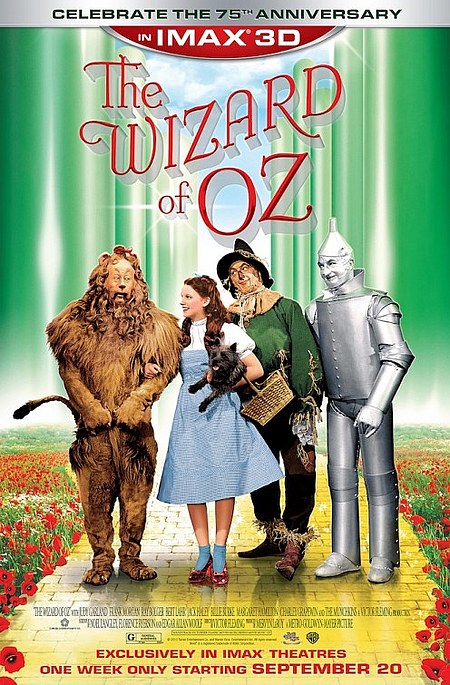The new IMAX 3D version of the original 1939 classic “The Wizard of Oz” averaged a staggering $9,500 at each of the only 300-plus theaters showing the movie over the Sept. 20-22, 2013 weekend. The combined $3 mllion was strong enough for 9th place on the weekend even though it was only in one-tenth the number of theaters of all but one of the other nine films on the top ten list.
It landed just ahead of Disney’s $50 million dollar Blu-ray 3D-enhanced movie “Planes,” which is now up to $86.5 million after seven weeks.
 The company that performed the 2D-to-3D conversion on the oldest movie yet is Prime Focus World, which began with receipt of the restored and digitally re-mastered reels of the film. Warner Bros. went all the way back to the film’s original Technicolor camera negative, stored for many years at George Eastman House, and performed a full photo-chemical restoration before scanning the negative at 4K and digitally restoring the picture. The film has never before been seen at such a high resolution.
The company that performed the 2D-to-3D conversion on the oldest movie yet is Prime Focus World, which began with receipt of the restored and digitally re-mastered reels of the film. Warner Bros. went all the way back to the film’s original Technicolor camera negative, stored for many years at George Eastman House, and performed a full photo-chemical restoration before scanning the negative at 4K and digitally restoring the picture. The film has never before been seen at such a high resolution.
Approximately 1300 staff worked on the conversion of “The Wizard of Oz” across PFW’s Los Angeles and Mumbai studios, according to a spokesman for PFW, and the production ran from early look development tests beginning in November 2011 through to final delivery in January 2013.
“We have an acute awareness of this film’s position and importance in American cinema history, and we have been hugely sensitive to the original material,” said Merzin Tavaria, Co-Founder and Chief Creative Director at PFW. “This was a very prestigious project for Prime Focus World to work on, and to have the trust of Warner Bros. with perhaps the most precious film in their library is humbling.”
Working with the Warner Bros. supervisors, PFW made the decision to ‘break the walls’ of the stage-set backgrounds, selectively adding depth to some of the painted backdrops to further the illusion of the environments they were depicting – including the yellow brick road, which now appears to continue to stretch away from the viewer even though it is just painted scenery.
PFW also used depth to creative effect on some of the characters. For example, the Wicked Witch of the West’s nose was extruded and the sculpting of her face was distorted slightly in 3D, and her hat and fingers were slightly exaggerated – subtle depth cues that make her appear even scarier on-screen. Similarly, PFW used conversion techniques to make the Munchkins appear smaller in relation to the other characters and objects in the scene.
There was one scene in particular that was earmarked from the start of the project as deserving special attention in the 3D conversion – Dorothy’s first steps into Oz. PFW had created a fair amount of depth for the sepia scenes leading up to this moment, but the conversion house used the stepping through the door into Oz as an opportunity to significantly open up the depth. As Dorothy steps through her front door, the world of Oz literally opens up before her, in glorious Technicolor with a swelling musical score and with fantastic 3D depth to the scene.
— By Scott Hettrick
